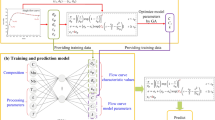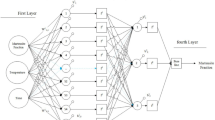Abstract
An artificial neural network (ANN) model was developed to predict the microstructural evolution of a 15Cr-15Ni-2.2Mo-Ti modified austenitic stainless steel (Alloy D9) during dynamic recrystallization (DRX). The input parameters were strain, strain rate, and temperature whereas microstructural features namely, %DRX and average grain size were the output parameters. The ANN was trained with the database obtained from various industrial scale metal-forming operations like forge hammer, hydraulic press, and rolling carried out in the temperature range 1173-1473 K to various strain levels. The performance of the model was evaluated using a wide variety of statistical indices and the predictability of the model was found to be good. The combined influence of temperature and strain on microstructural features has been simulated employing the developed model. The results were found to be consistent with the relevant fundamental metallurgical phenomena.









Similar content being viewed by others
Notes
There were two models, one for %DRX and another for average grain size. However, in the text sometimes the word “model” is used to refer to the two models collectively.
References
R.W. Cahn and P. Haasen, Physical Metallurgy, Vol. III, 4th ed., North Holland, 1996
T. Sakai, J.J. Jonas 1984 Dynamic Recrystallization: Mechanical and Microstructural Considerations. Acta Metal. 32(2):89–209
S. Mandal, P.V. Sivaprasad, R.K. Dube 2006 Kinetics, Mechanism and Modelling of Microstructural Evolution During Thermomechanical Processing of a 15Cr-15Ni-2.2Mo-Ti Modified Austenitic Stainless Steel. J. Mater. Sci. 42:2724–2734
C.M. Sellars 1990 Modeling Microstructural Development During Hot Rolling. Mater. Sci. Technol. 15:1072
M.F. Ashby 1992 Physical Modeling of Materials Problem. Mater. Sci. Technol. 8:102
T.W. Kim, F.P.E. Dunne 1999 Modeling Heterogeneous Microstructure in Superplasticity. Proc. R. Soc. Lond. A Math. Phys. Sci. 455:719
T. Sakai, M. Ohashi, K. Chiba, J.J. Jonas 1988 Recovery and Recrystallization of Polycrystalline Nickel After Hot Working. Acta Metal. 36(7):1781–1790
W.C. Liu, J.G. Morris 2005 Effect of Initial Texture on the Recrystallization Texture of Cold Rolled AA 5182 Aluminum Alloy. Mater. Sci. Eng. A 402(1–2):215–227
S. Haykin 1999 Neural Networks: A Comprehensive Foundation. Prentice Hall, Upper Saddle River, New Jersey
S.C. Juang, Y.S. Tarang, H.R. Lii 1998 A Comparison Between the Back-Propagation and Counter-Propagation Networks in the Modeling of the TIG Welding Process. J. Mater. Process. Technol. 75(1–3):54–62
M.S. Chun, J. Biglou, J.G. Lenard, J.G. Kim 1999 Using Neural Networks to Predict Parameters in the Hot Working of Aluminum Alloys. J. Mater. Process. Technol. 86(1–3):245–251
M. Riedmiller and H. Braun, A Direct Adaptive Method for Faster Back Propagation Learning: The RPROP Algorithm. Proceedings of International Conference in Neural Networks, San Francisco, CA, 1993
M. Riedmiller, Advanced Supervised Learning in Multi-layer Perceptrons - From Backpropagation to Adaptive Learning Algorithms, Special Issue on Neural Networks, Int. J. of Comp. Stand. Inter., 1994, 16, p 265–278
T. Tollenaere 1990 SuperSAB: Fast Adaptive Back Propagation with Good Scaling Properties, Neural Network 3(5):561–573
Y.V.R.K. Prasad and N. Ravichandran (1991) Effect of Stacking Fault Energy on the Dynamic Recrystallization During Hot Working of FCC Metals: A Study Using Processing Maps, Bull. Mater. Sci. 14:1241–1248
S. Mandal, P.V. Sivaprasad, S. Venugopal, and K.P.N. Murthy, Constitutive Flow Behaviour of Austenitic Stainless Steels Under Hot Deformation: Artificial Neural Network Modeling to Understand, Evaluate and Predict. Model. Simul. Mater. Sci. Eng., 2006, 14, p 1053
S. Venugopal, P.V. Sivaprasad, and S. Venkadesan, Effect of Annealing Temperature on Engineering Properties of Alloy D9, Unpublished Work
D. Ponge, G. Gottstein 1998 Necklace Formation During Dynamic Recrystallization: Mechanisms and Impact on Flow Behavior. Acta Mater. 46(1):69–80
E. Brunger, X. Wang, G. Gottstein 1998 Nucleation Mechanisms of Dynamic Recrystallization in Austenitic Steel Alloy 800H. Scripta Mater. 38(12):1843–1849
K. Hornik, M. Stinchcombe, H. White 1989 Multilayer Feed Forward Networks are Universal Approximations. Neural Network 2(5):359–366
J.D. Olden, D.A. Jackson 2002 Illuminating the “Black Box”: A Randomization Approach for Understanding Variable Contributions in Artificial Neural Networks. Ecol. Model. 154(1–2):135–150
M. Gevrey, I. Dimopoulos, S. Lek 2003 Review and Comparison of Methods to Study the Contribution of Variables in Artificial Neural Network Models. Ecol. Model. 160 (3):249–264
J.D. Olden, M.K. Joy, R.G. Death 2004 An Accurate Comparison of Methods for Quantifying Variable Importance In Artificial Neural Networks Using Simulated Data. Ecol. Model. 178(3–4):389–397
G.D. Garson 1991 Interpreting Neural Network Connection Weights. Artif. Intell. Expert 6(7):47–51
A.T.C. Goh 1995 Back-Propagation Neural Networks for Modelling Complex Systems. Artif. Intell. Eng. 9:143–151
Acknowledgments
The authors would like to express their sincere thanks to Dr. S. Venugopal, Head, Metal Forming & Tribology Section and Dr. S.K. Ray, Head, Materials Technology Division for useful discussions. The authors also gratefully acknowledge Dr. Baldev Raj, Director, Indira Gandhi Centre for Atomic Research (IGCAR) for his constant encouragement throughout the course of this work.
Author information
Authors and Affiliations
Corresponding author
Rights and permissions
About this article
Cite this article
Mandal, S., Sivaprasad, P. & Dube, R. Modeling Microstructural Evolution During Dynamic Recrystallization of Alloy D9 Using Artificial Neural Network. J. of Materi Eng and Perform 16, 672–679 (2007). https://doi.org/10.1007/s11665-007-9098-z
Received:
Revised:
Published:
Issue Date:
DOI: https://doi.org/10.1007/s11665-007-9098-z




